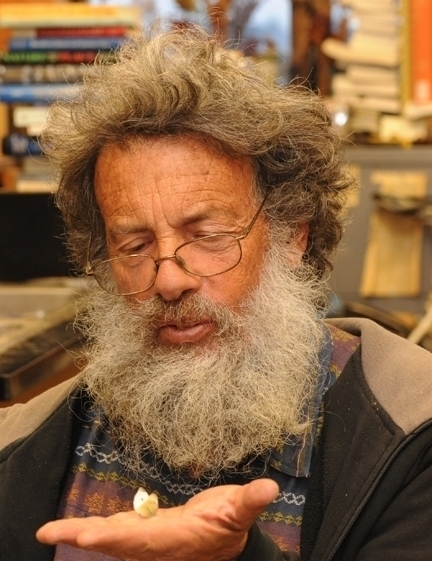
As of 4 p.m. today (Jan. 6), the two UC Davis "bug contests" underway--one, to collect the first cabbage white butterfly of the year in the three-county area of Sacramento, Yolo and Solano, and two, to photograph the first bumble bee of the year in the two-county area of Yolo and Solano--have yielded no winners.
UC Davis distinguished professor Art Shapiro, who sponsors the "Beer for a Butterfly" Contest (he'll trade you a pitcher of beer or its equivalent if you collect the first cabbage white butterfly, Pieris rapae), blames it on the rain. And more to come.
Shapiro was out looking for P. rapae today and "got wet and muddy but no bugs." He celebrated anyway with a beer. After all, today is his birthday!
And the rain?
"This may be the end of the world," he wrote in a group email (subject: "GLUB") on Jan. 5. "Periods of rain are expected every day through perhaps the 19th, with heavy rain and high winds on several occasions, beginning early next week. At least 6" more of rain can be expected in the Valley through Friday the 13th, with 10-20" on the west slopes of the Sierra and Coast Range. A megaflood scenario a la 1861-62 is unlikely-- but not out of the question. No discharges are yet expected into the Yolo Bypass, but that will probably change next week. Do not expect any butterfly records any time soon. Everybody stay safe and prepared for whatever may eventuate."
The barometer dropped to 29.54" on Wednesday morning, he added. "It's nowhere near a record but quite low."
Cabbage White Butterfly Contest
Shapiro, a member of the Department of Evolution and Ecology faculty, has sponsored the “Suds for a Bug” contest since 1972 to determine the butterfly's first flight of the year. He launched the contest as part of his long-term studies of butterfly life cycles and climate change.
P. rapae is emerging earlier and earlier as the regional climate has warmed, said Shapiro. "Since 1972, the first flight of the cabbage white butterfly has varied from Jan. 1 to Feb. 22, averaging about Jan. 20."
The contest rules include:
- It must be an adult (no caterpillars or pupae) and be captured outdoors.
- It must be brought in alive to the Department of Evolution and Ecology office, 2320 Storer Hall, UC Davis, during work hours, 8 a.m. to 5 p.m., Monday through Friday, with the full data (exact time, date and location of the capture) and the contact information of the collector (address, phone number and/or e-mail.) The receptionist will certify that it is alive and refrigerate it. (If it's collected on a weekend or holiday, it can be kept in the refrigerator for a few days--do not freeze it.)
- Shapiro is the sole judge.
The professor said P. rapae inhabits vacant lots, fields and gardens where its host plants, weedy mustards, grow. The male is white. The female is often slightly buffy; the "underside of the hindwing and apex of the forewing may be distinctly yellow and normally have a gray cast,” Shapiro said. “The black dots and apical spot on the upperside tend to be faint or even to disappear really early in the season.” In its caterpillar stage, it is a pest commonly called "cabbageworm."
Shapiro, who monitors butterfly populations in the field for more than 200 days of the year and posts information on his research website at http://butterfly.ucdavis.edu/, usually wins the contest. He has been defeated only four times and those were by UC Davis graduate students. Adam Porter won in 1983; Sherri Graves and Rick VanBuskirk each won in the late 1990s; and Jacob Montgomery in 2016. The first three were his own graduate students.
Shapiro is the author of A Field Guide to Butterflies of the San Francisco Bay and Sacramento Valley Regions, illustrated by Tim Manolis and published in 2007 by the University of California Press.
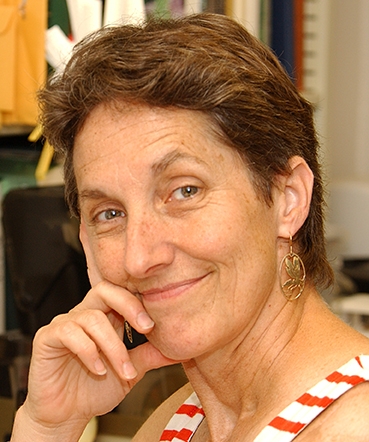
The Robbin Thorp Memorial First-Bumble Bee-of-the-Year Contest, the third annual, is sponsored by the Bohart Museum of Entomology. The first person to photograph a bumble bee in either Yolo or Solano and email the image to the sponsor, will receive a coffee cup designed with the endangered Franklin's bumble bee, the bee that Thorp monitored on the California-Oregon border for decades.
Contest coordinator Lynn Kimsey, director of the Bohart Museum and a UC Davis distinguished professor of entomology, said the image must be taken in the wild and emailed to bmuseum@ucdavis.edu, with the time, date and place. The image must be recognizable as a bumble bee.
The first bumble bees to emerge in this area are the black-tailed bumble bee, Bombus melanopygus, and the yellow-faced bumble bee, B. vosnesenskii.
The contest memorializes Professor Thorp (1933-2019), a global authority on bees and a UC Davis distinguished emeritus professor of entomology, who died June 7, 2019 at age 85. A 30-year member of the UC Davis faculty, he retired in 1994 but continued working until several weeks before his death. Every year he looked forward to seeing the first bumble bee in the area.
Two scientists shared the 2022 prize: UC Davis doctoral candidate Maureen Page of the Neal Williams lab, UC Davis Department of Entomology and Nematology (who now holds a Ph.D) and horticulturist Ellen Zagory, retired director of public horticulture for the UC Davis Arboretum and Public Garden. They each photographed a bumble bee foraging on manzanita (Arctostaphylos) in the 100-acre Arboretum at 2:30 p.m., Saturday, Jan. 1.
Page photographed a B. melanopygus, while Zagory captured an image B. vosnesenskii. Fittingly, they both knew and worked with Thorp, a tireless advocate of pollinator species protection and conservation and the co-author of Bumble Bees of North America: An Identification Guide (Princeton University, 2014) and California Bees and Blooms: A Guide for Gardeners and Naturalists (Heyday, 2014).
This marked the second consecutive win for a member of the Williams lab. Postdoctoral researcher Charlie Casey Nicholson of the Williams lab and the Elina Lastro Niño lab, won the 2021 contest by photographing a B. melanopygus at 3:10 p.m., Jan. 14 in a manzanita patch in the Arboretum.
Both Page and Nicholson are alumni of The Bee Course, which Thorp co-taught from 2002-2018. Page completed the course in 2018, and Nicholson in 2015. In July 2016, Page participated in a "Bumble Bee Blitz" organized by Thorp and the U. S. Fish and Wildlife Service on Mt. Ashland, where, she said, "we searched for Bombus franklini and Bombus occidentalis--two very rare west coast bee species. We unfortunately did not find B. franklini, which is now recognized as an endangered species under the Endangered Species Act.”
The prized coffee cup features an image of the bee specimen, photographed by Bohart scientist Brennen Dyer, now collections manager, and designed by UC Davis doctoral alumnus Fran Keller, a professor at Folsom Lake College. Previous winners are ineligible to win the prize.
The bumble bee contest originated as an impromptu contest in 2012 as a little rivalry between the late Professor Thorp and his "posse"--three of his bumble bee aficionados: Allan Jones, Gary Zamzow, and Kathy Keatley Garvey.
Attached Images:
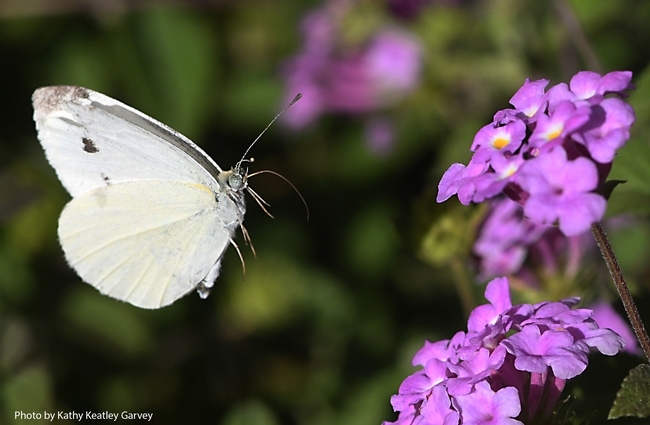
A cabbage white butterfly, Pieris rapae, in flight, heading toward lantana. (Photo by Kathy Keatley Garvey)
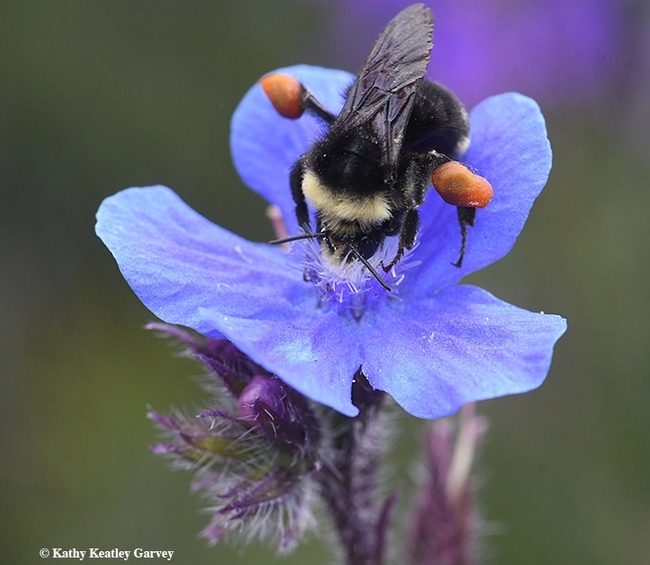
A yellow-faced bumble bee, Bombus vosnesenskii, foraging on Italian Italian bugloss, Anchusa azurea. (Photo by Kathy Keatley Garvey)
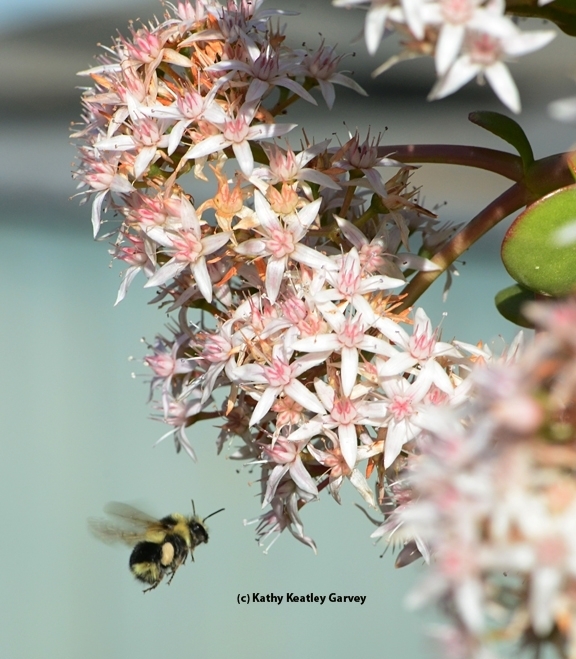
A black-tailed bumble bee, Bombus melanopygus, heading for a jade blossom. (Photo by Kathy Keatley Garvey)